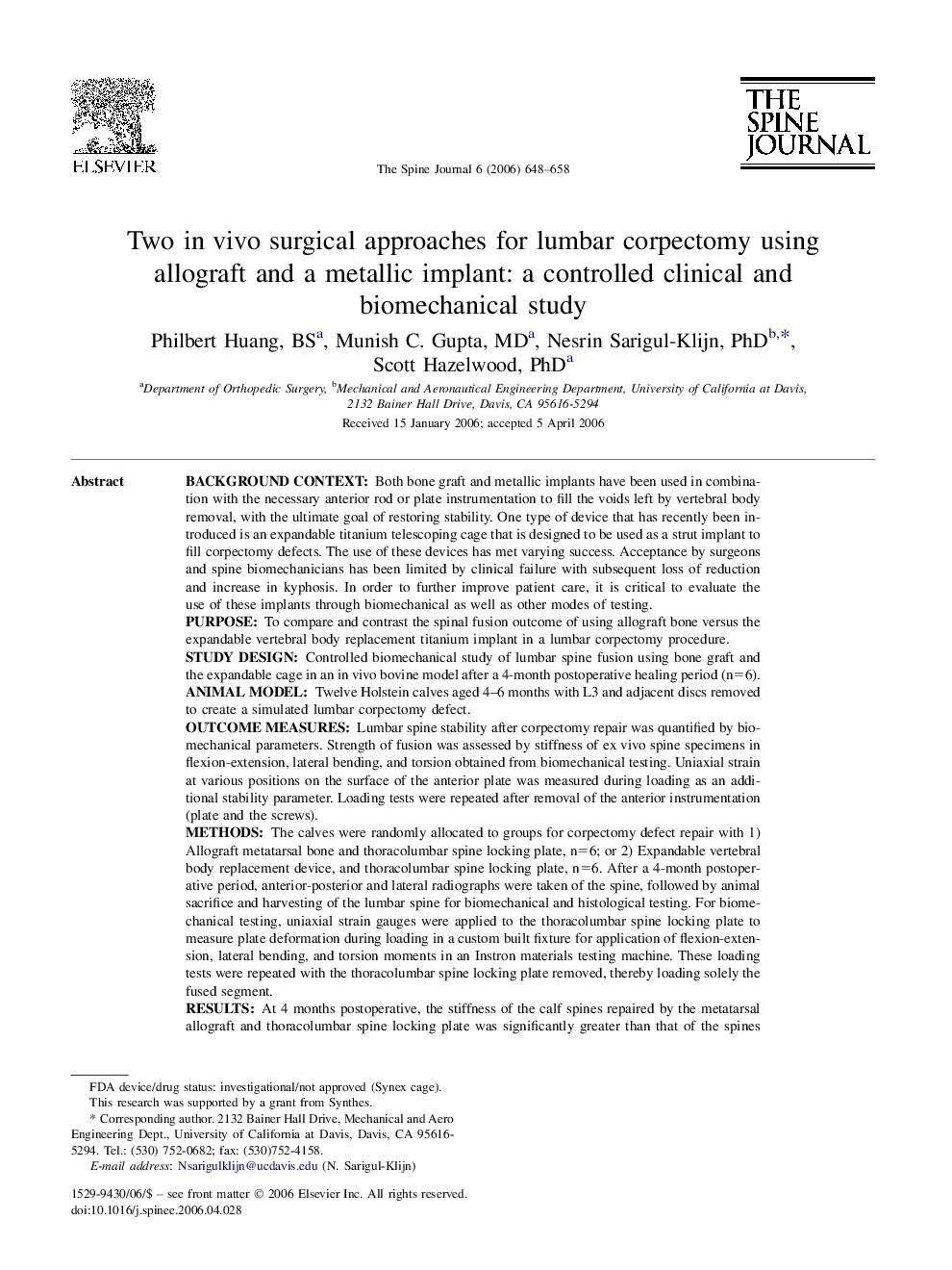| کد مقاله | کد نشریه | سال انتشار | مقاله انگلیسی | نسخه تمام متن |
|---|---|---|---|---|
| 4100120 | 1268671 | 2006 | 11 صفحه PDF | دانلود رایگان |

Background contextBoth bone graft and metallic implants have been used in combination with the necessary anterior rod or plate instrumentation to fill the voids left by vertebral body removal, with the ultimate goal of restoring stability. One type of device that has recently been introduced is an expandable titanium telescoping cage that is designed to be used as a strut implant to fill corpectomy defects. The use of these devices has met varying success. Acceptance by surgeons and spine biomechanicians has been limited by clinical failure with subsequent loss of reduction and increase in kyphosis. In order to further improve patient care, it is critical to evaluate the use of these implants through biomechanical as well as other modes of testing.PurposeTo compare and contrast the spinal fusion outcome of using allograft bone versus the expandable vertebral body replacement titanium implant in a lumbar corpectomy procedure.Study designControlled biomechanical study of lumbar spine fusion using bone graft and the expandable cage in an in vivo bovine model after a 4-month postoperative healing period (n=6).Animal modelTwelve Holstein calves aged 4–6 months with L3 and adjacent discs removed to create a simulated lumbar corpectomy defect.Outcome measuresLumbar spine stability after corpectomy repair was quantified by biomechanical parameters. Strength of fusion was assessed by stiffness of ex vivo spine specimens in flexion-extension, lateral bending, and torsion obtained from biomechanical testing. Uniaxial strain at various positions on the surface of the anterior plate was measured during loading as an additional stability parameter. Loading tests were repeated after removal of the anterior instrumentation (plate and the screws).MethodsThe calves were randomly allocated to groups for corpectomy defect repair with 1) Allograft metatarsal bone and thoracolumbar spine locking plate, n=6; or 2) Expandable vertebral body replacement device, and thoracolumbar spine locking plate, n=6. After a 4-month postoperative period, anterior-posterior and lateral radiographs were taken of the spine, followed by animal sacrifice and harvesting of the lumbar spine for biomechanical and histological testing. For biomechanical testing, uniaxial strain gauges were applied to the thoracolumbar spine locking plate to measure plate deformation during loading in a custom built fixture for application of flexion-extension, lateral bending, and torsion moments in an Instron materials testing machine. These loading tests were repeated with the thoracolumbar spine locking plate removed, thereby loading solely the fused segment.ResultsAt 4 months postoperative, the stiffness of the calf spines repaired by the metatarsal allograft and thoracolumbar spine locking plate was significantly greater than that of the spines repaired by the expandable cage and thoracolumbar spine locking plate. This finding was true for all three directions of loading (flexion-extension, left-right lateral bending, and torsion). Concordantly, the neutral zone, elastic zone, and range of motion of the spines repaired with the allograft bone were less than that of the spines repaired with the expandable cage. Greater strain values were observed from the gauges on the thoracolumbar spine locking plate of the spines using the expandable cage than the spines using allograft bone. This finding held for all gauge positions (anterior edge, anterior face, posterior edge, and posterior face at the longitudinal midpoint of the plate). After thoracolumbar spine locking plate removal and a repeat of the loading tests, a decrease in stiffness of the construct and a rise in the motion parameters were observed for both the allograft and cage groups.ConclusionsThe use of allograft bone for corpectomy defect repair in the lumbar spine appears to contribute to a stiffer and perhaps more stable spine segment compared with using the expandable cage device for such a repair after a 4-month healing period in this in vivo calf model. These findings thus far are based upon the biomechanical data gathered.
Journal: The Spine Journal - Volume 6, Issue 6, November–December 2006, Pages 648–658